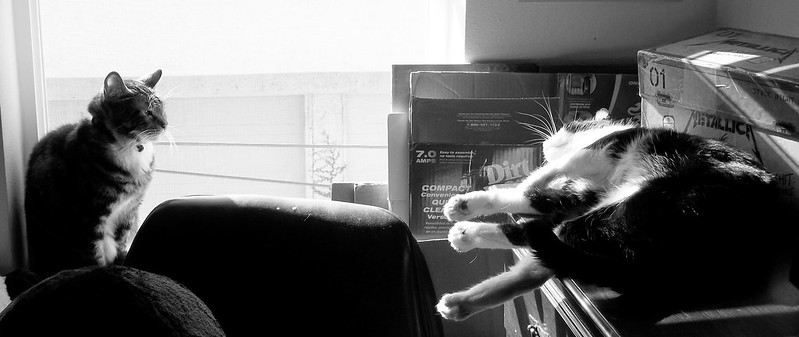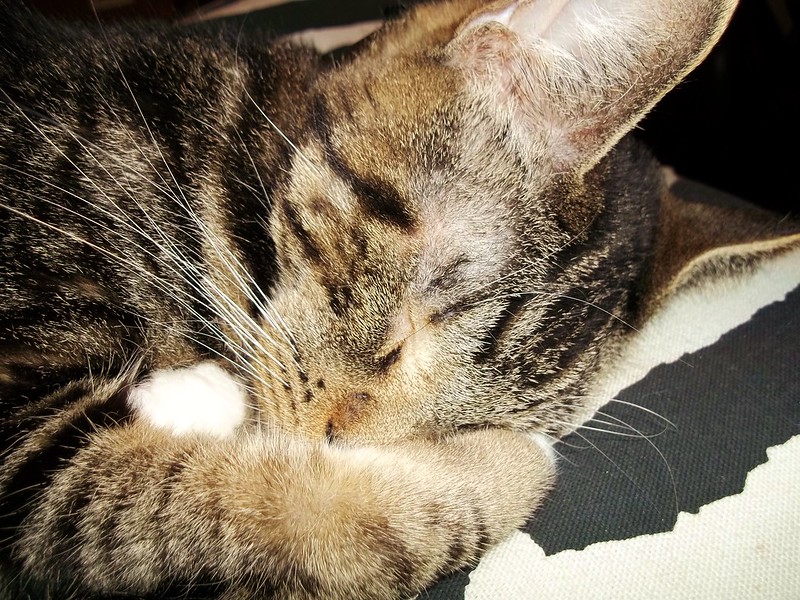Some might call me spoiled. I was the runt of my litter, and the last to be adopted, after my true mother went missing. Not even a pound, and covered in fleas, my human took me home, where we spend nearly every moment of every day inseparable, for several months. While I adored all of the attention, this increased an already existing anxiety and fear for that outside my home. Whenever anyone would come to the door, or even pass by the window, I'd run and hide in fear. There was even quite an embarrassing episode involving a mouse, that I'm not too proud of! It's fair to say I was likely one of the worst candidates for a multi-pet home, at 2 years old and used to a single human inhabitant. So, when our family grew by one, cat, there was quite a bit of hesitation by all, and several weeks of holding breath. How do you convince your only child (cat) that a new child (cat) is not going to steal their territory or overtake the established love from their owner? Just like humans, pets can often feel replaced, or even threatened (territorially), when a new member is introduced, and I was no exception.

Unlike adding a new human, baby, to your family, there is some luxury of being able to match your furry companion to the new addition. It's important to consider the temperament, age, and size of your new cat, in comparison to the existing family member. In our case, I was a 6lb 2 year old female (who was not fixed, and had existing anxiety). I was unfamiliar with other animals, not used to sharing my space and in most cases quite defensive of my things, people, and territory. While bringing home a kitten would have posed less of a threat, in size, to me, it would have been rambunctious and unpredictable. I might have seen the new kitten as a threat, even though it was merely playful, and reacted poorly (perhaps even causing harm) to it's playful interactions. Never mind how stressful ti can be simply introducing new cats (when one has anxiety), without having to handle all the obstacles of a kitten!
So Jenna and Jeremy decided they would go the other route, and select a cat that was more docile and easy going. Not only would they be saving a cat that was otherwise an adult, and considered at high risk for euthanization (people usually want to adopt cute and cuddly kittens, not full grown cats), but in choosing an older cat they would likely avoid the hurdles of litter training, and have the option of selecting a pre-developed personality. While 1.5 year old Frankie was in fact a bear of a cat in comparison to me, he would be able to withstand any misunderstandings (should there be any), and was much more calm than those younger (also fixed, which made him less active). Frankie, who gets his attributes from a feral clan of cats, has clearly been around multiple animals and people his entire life. He was used to being surrounded by fast, playful kittens, and cared not if there was a parade going past him- he'd spend most of his days sleeping.

The next hurdle is bringing the new family member home. It is important that you do not create a situation where the original cat feels threatened or replaced. To begin initial introductions you will need to separate the cats, placing the new cat (B) in a quarantined room, or section of the home. Separating Cat B will enable the original cat (A) to maintain control of it's own designated area, keeping it's scent and pheromone markings. When cat (B) is not properly separated upon introduction it will often mark the entire house (often represented by whisker rubbing), and cause animosity with Cat A! Cat A will initially interact, and smell, the new cat through the doors, and at door bases. You should be able to judge your original cats intentions and comfort based on how it reacts at the doorway. Depending on your cat's comfort level it can take days to weeks for it to adjust to the thought of the new animal. Often you will notice a change from growling and hissing to actual play and under the door pawing instigated by Cat A.
Until Cat A exhibits a positive interest in Cat B, it is essential you wash your hands after all interactions with Cat B. Us cats can smell the distinct pheromones, and you might instigate unwanted jealousy if you're not careful. It's also important to remember that, in most cases, Cat A will require additional affection and attention during this adjustment period. Showing your original cat more, and quality, 1 on 1 time will reinforce that it is not being replaced. Once you are ready to make the 'official' face to face introductions, you can choose to open the door, or move on to cage/pen introductions (where Cat B is allowed within Cat A's territory, within a confined pen or cage). This may be necessary with particularly difficult cases of Cat A's personality. If you have a large home or space, most often you should be able to allow both cats to roam the same space (after the proper separation period).
So long as neither cat is physically threatening the other, some growling and even hissing may be normal. (Just remember, NEVER try to break up a cat fight!) In the case a fight does break out, ensure that there are sufficient 'safe' spots for either cat to retreat to. So long as each animal has designated space, and plenty of room, they will naturally coexist to their comfort level. In time, both cats should learn to tolerate one another, and perhaps even become friends. It took me about 10 days of separation training, and an additional 2 weeks of adjustment period to approach Frankie without growling. Now I will often chase after his fluffy tail (much to his careless annoyance), and feel comfortable allowing him to pass by in close quarters, without feeling threatened. Good luck!
Until Cat A exhibits a positive interest in Cat B, it is essential you wash your hands after all interactions with Cat B. Us cats can smell the distinct pheromones, and you might instigate unwanted jealousy if you're not careful. It's also important to remember that, in most cases, Cat A will require additional affection and attention during this adjustment period. Showing your original cat more, and quality, 1 on 1 time will reinforce that it is not being replaced. Once you are ready to make the 'official' face to face introductions, you can choose to open the door, or move on to cage/pen introductions (where Cat B is allowed within Cat A's territory, within a confined pen or cage). This may be necessary with particularly difficult cases of Cat A's personality. If you have a large home or space, most often you should be able to allow both cats to roam the same space (after the proper separation period).
So long as neither cat is physically threatening the other, some growling and even hissing may be normal. (Just remember, NEVER try to break up a cat fight!) In the case a fight does break out, ensure that there are sufficient 'safe' spots for either cat to retreat to. So long as each animal has designated space, and plenty of room, they will naturally coexist to their comfort level. In time, both cats should learn to tolerate one another, and perhaps even become friends. It took me about 10 days of separation training, and an additional 2 weeks of adjustment period to approach Frankie without growling. Now I will often chase after his fluffy tail (much to his careless annoyance), and feel comfortable allowing him to pass by in close quarters, without feeling threatened. Good luck!



I Love Cats Too. Thank you for the giveaway. Jerri DAvis
ReplyDeleteThis is very good, thorough advice for introducing a new cat to a home with another cat. Sometimes that can be hard! We had five cats at one time and a couple never did get along with each other but they co-existed somewhat
ReplyDeleteDigicats {at} Sbcglobal {dot} Net